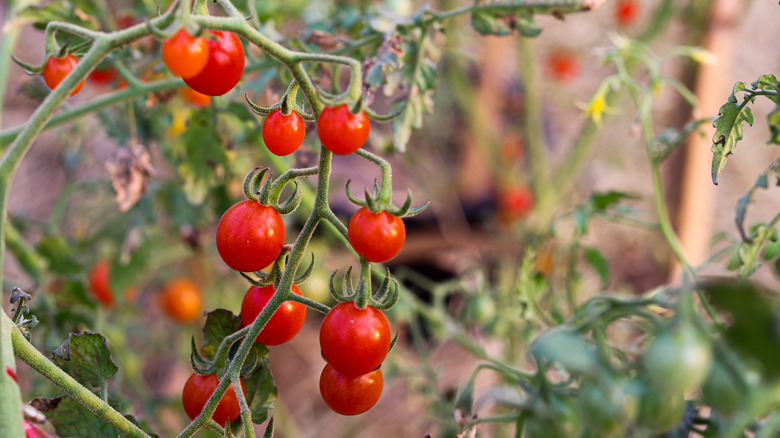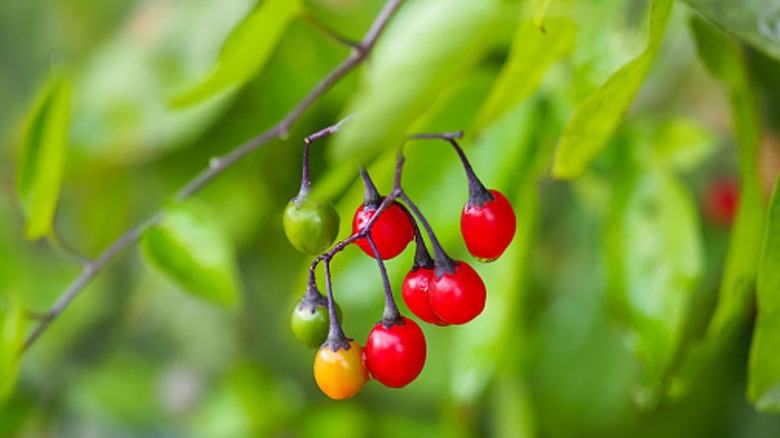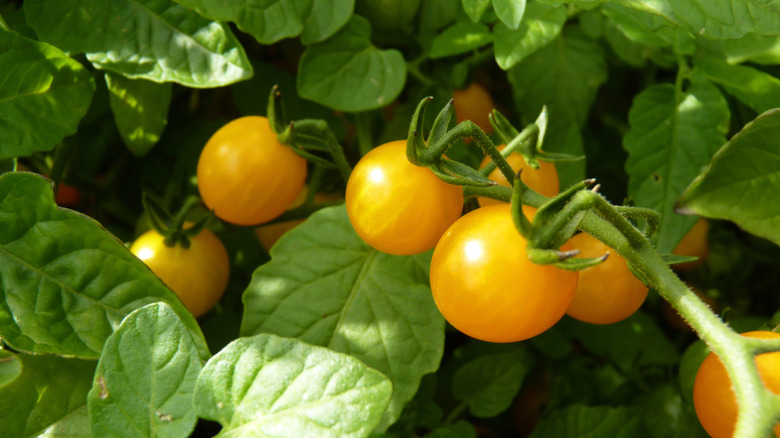How To Tell Currant Tomatoes Apart From Their Dangerous Garden Twin
Several plants share a resemblance but aren't safe at all to touch or eat. Currant tomatoes (Solanum pimpinellifolium) are a delicious variety of tomatoes, widely enjoyed for their delightful burst of flavor in such a small fruit. A lot of people probably don't know that these tomatoes belong to the nightshade group of plants, a fact that would send gasps ringing about like shockwaves. Nightshades are notorious for some of the most poisonous species of plants around which is why you need to be able to tell currant tomatoes apart from their dangerous garden twin: the bittersweet nightshade (Solanum dulcamara). This is easily achieved by checking the colors of their flower petals.
If you saw the currant tomato and bittersweet nightshade plants side by side, you'd understand why being able to identify which is which could potentially save a life. They both produce tiny, round, red fruit that hang down from the plant in similar clusters. At first glance, it may be next to impossible to tell them apart from each other, but the flowers give their positions away. Bittersweet nightshade contains solanine and dulcamarine, poisonous compounds that can cause vomiting, diarrhea, and death. Since bittersweet nightshade can sprout just about anywhere, you don't want to accidentally eat one of its berries.
Currant tomatoes have yellow flowers while bittersweet nightshades rock purple ones
Being a plant keeper means knowing how to differentiate between plants and fruit that look alike in order to keep yourself and others safe from harm. The best way to tell currant tomatoes apart from their deadly cousin bittersweet nightshade is through their gorgeous flowers. Currant tomatoes have yellow flowers while bittersweet nightshade blooms a rich violet color with a yellow stamen in the middle.
Even the appearance of the fruit of both plants bear a recognizable contrast to each other. Currant tomatoes have green stalks and their sepals are long and green with that tomato-y flare. On the other hand, the berries of the bittersweet nightshade are often connected by darker stalks and have no flared sepals. By looking closely at the fruit of the plant you've stumbled upon, you'll be able to tell it for what it is.
You can admire the deep purple flowers of the bittersweet nightshade from afar if you're strolling along a nature trail, but it is absolutely unsafe for you to even consider planting these in your garden or anywhere near your yard. Even if you never eat from it, there's no guarantee that your pets, kids, or even wildlife like deer would resist its bittersweet leaves or enticing red berries. Bittersweet nightshade is toxic to all of the above and more. Currant tomatoes, however, are welcome in the household garden and you even have tasty varieties to choose from.
There are other varieties of currant tomatoes in other colors
Currant tomatoes are bite-sized fruits and are some of the easiest tomatoes to grow in your garden. Although the red varieties are more popular and the ones that you'd have to tell apart from bittersweet nightshade berries, there are other colors of currant tomato fruit as well such as yellow and pale. Selecting which tomato variety would be best for your yard boils down to your tastes. If you're in the market for a sweet and sour kind of garnishing, you'll love the Lemon Drop currant tomato variety. They are yellow when ripe, similar to the Gold Rush variety. Also popular are the red varieties Sweet Pea and Hawaiian.
Growing these tomatoes is fairly simple and they often mature in a matter of a few months, bearing enough fruit for the entire household from just a few plants. Your new currant tomato seedlings should start in a container or nursery and be transplanted into new soil as they get bigger. This is to ensure that they survive their first winter so that the cold poses no threat. After this time elapses, you can finally take them outdoors. Currant tomatoes love full sunlight and nutritious, well-drained soil. Don't forget to plant them at least three feet away from the rest of those in your veggie garden. They are excited growers and the vines can reach a considerable length and size.


